

THE BOATS: AC75, AC40 & LEQ12
Although foiling feels like a recent revolution to take the world of watersports by storm, it has been at the heart of America's Cup racing for over 10 years.
It was August 2012 when the sailing world was turned upside down by a 72-foot catamaran flying in the Hauraki Gulf. Emirates Team New Zealand had brought foils to the America's Cup, changing the face of top-level yacht racing forever.
Six years later, in 2018, the publication of the AC75 Class Rule marked the beginning of a new sailing era. The engineering and sailing techniques needed to get the AC75 to fly completely differed from anything seen before.
During the 36th America's Cup in 2021, the AC75 proved themselves to be unique and kept millions of fans worldwide glued to their screens. It was then no surprise that the organisers were keen to continue with the AC75 rule for the Louis Vuitton 37th America’s Cup in Barcelona, albeit with several improvements to promote faster flight and incorporate upgraded technology. But the organisers went further. With a focus on youth and women being paramount to growing the sport into the future, a new class of boats was introduced–the AC40–specifically for this purpose. As the smaller sister-ship of the AC75, the AC40 launched in Auckland to much acclaim with speeds hitting the "high 40s" almost immediately straight out of the box under the skillful command of Emirates Team New Zealand in September 2022.

AC75: AMERICA'S CUP BOAT
On the 15th of November 2021, eight months after the Kiwis successfully defended the America's Cup, an updated 'Version 2' of the AC75 Class Rule was released.
The boats will be a step on from what we saw in Auckland in 2021. The foils will be larger to promote quicker lift and faster flight. The boats will be lighter and, onboard, the electronics and software systems will be vastly upgraded. To save weight, the number of crew on the AC75 has been reduced from 11 to 8. The move to reduce the crew means cycle power is again legalised, and the cyclors, introduced by Emirates Team New Zealand in 2017, might return to the game.
Several of the elements are strict one-design, such as the mast, rigging, foil cant-arms and cant hydraulics but the scope for design elsewhere is broad. To keep costs under control, it was also determined that teams would only be allowed to build one AC75 so the demand on getting the design right is at a premium. The boats will be expected to fly at speeds touching 50 knots in winds that average 12 knots in late summers in Barcelona.
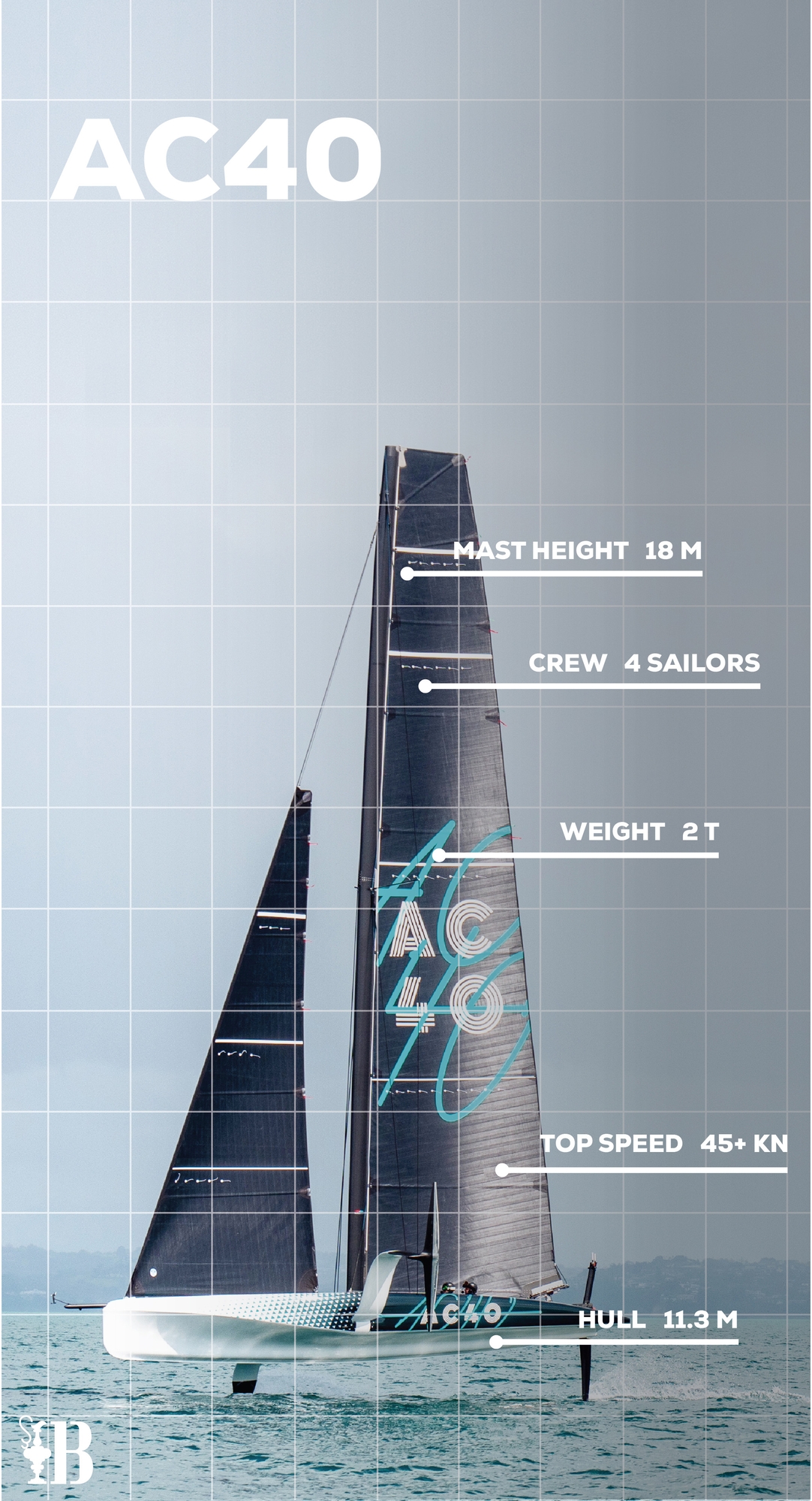
AC40: YOUTH, WOMEN & TRAINING
New for the Louis Vuitton 37th America's Cup, the AC40 is a multi-use foiling monohull that all the confirmed teams will use for sailing and testing purposes. The AC40 is also the nominated boat for both the UniCredit Youth & Puig Women’s America’s Cup events where they will be sailed in strict one-design. The confirmed teams will also use the AC40 in competitive events leading up to the America’s Cup and several of the teams have two boats on order. The AC40 is being built by McConaghy’s in China. The foils and systems are being delivered by the Emirates Team New Zealand North Shore Facility and delivered in strict order of entry to the America’s Cup. Teams may modify and test out componentry on the AC40, and for this purpose, they will be deemed as a LEQ12 (see below), but for competition purposes in the UniCredit Youth & Puig Women’s America’s Cup, they will be returned to one-design according to strict rules around those specific events. Early trials of the AC40 by Emirates Team New Zealand have been sensational with speeds recorded in the ‘high-40-knot’ bracket and it is anticipated that this new class will form a global circuit both before and after the America’s Cup. For the UniCredit Youth & Puig Women’s America’s Cup, aside from the confirmed entries from the America's Cup syndicates, yacht clubs from around the world are being invited to form teams on a strict one-nation, one-entry basis and the finals of the youth and women’s events are scheduled on key dates of both the Louis Vuitton Cup (Challenger Selection Series) and Louis Vuitton 37th America's Cup Match dates.

LEQ12: TESTING ONLY
Entrants for the Louis Vuitton 37th America’s Cup are required to build one AC75 and purchase at least one AC40 but within the rules there is also the opportunity for teams to build one, new, test boat with the stipulation that it must be ‘Less than or Equal to 12 metres in overall length.’ The term LEQ12 was thus coined and it’s a nod to a well used term in computing ‘LEQ’ and was the most accurate description of the vessel. To date, two teams have built dedicated LEQ12s–INEOS Britannia and Luna Rossa Prada Pirelli–and these boats are loaded with sensors, cameras and measuring devices in order that the design team can collate data and calibrate their design software packages in a real-world environment. For the sailors too, it is an opportunity to hone monohull foiling techniques and have the ability to try new sailing styles as well as test new componentry in a relatively controlled environment, and with far fewer consequences than trialling something new on a powerful AC75 at full scale. The two specifically built LEQ12s to date are notably different in design with the Italian LEQ12 being of similar design to the winning ‘Te Rehutai’ of Emirates Team New Zealand during the 36th America's Cup whilst the British LEQ12 is a more extreme design to give a baseline of validation to the INEOS Britannia design team that is supported by Mercedes F1 Applied Science.
How many new AC75s can a team build
When agreeing on the new format for the 37th America’s Cup, the Defender and the Challenger of Record were determined to keep a lid on costs and deliver a sustainable event that could attract additional entries without a very high financial barrier to entry. During the 36th America's Cup, teams were allowed to build two AC75s but in the final Protocol for the 37th America's Cup, it was agreed that teams could only build one AC75 to compete in the America’s Cup in Barcelona. The introduction of the AC40 class allowed for teams to purchase these for either two-boat training or as test boats and a further concession was permitted in that teams could build one specific LEQ12 for testing and training purposes. By implementing the one-boat build rule for the 37th America's Cup, a high premium is placed on getting the final design right as there is little opportunity to change the fundamental design of the boats after launch. The world’s greatest naval architects, designers and engineers have been employed by all the teams with several partnering with complementary sports engineering functions such as Red Bull Advanced Technologies and Mercedes F1 Applied Science. The design race for the Cup is therefore, as intense as ever.
Can older AC75s be used and/or modified?
The first-generation AC75s that were used at the 36th America's Cup in 2021 may be used for training purposes by all of the confirmed teams in the run-up to the Louis Vuitton 37th America's Cup in Barcelona. To date, two teams–American Magic and Alinghi Red Bull Racing–have opted to re-launch these first-generation boats and use them as test boats and in the case of Alinghi Red Bull Racing, the Swiss who were not present during the 36th America's Cup, purchased Emirates Team New Zealand’s first boat ‘Te Aihe’ to train in Barcelona. There are, however, strict rules on developing these first-generation boats with the number of foil wings, flaps, rudders, foil arms, masts, hull surfaces and sails being strictly limited. This could well be the reason why the other teams have elected to develop LEQ12s or to adapt their AC40s into LEQ12s, as is the case with Emirates Team New Zealand, where the limits on componentry and testing are far less stringent, affording more scope for design development and analysis.
When does an AC40 become an LEQ12?
As mentioned above, in relation to the AC40, these boats are delivered in one-design format, but some teams may elect to take them out of one-design to test out componentry, and in this case, those AC40s will be deemed as ‘LEQ12s’ until returned to one-design configuration again. Change anything on your AC40 outside of the very strict class rules on componentry, and it becomes a LEQ12. In order for it to be used in the planned pre-regattas or the UniCredit Youth & Puig Women’s America’s Cup events it must be returned to the agreed one-design. Immediately after the necessary commissioning process of the very first AC40 that was delivered to Emirates Team New Zealand in September 2022, the team made changes to the cockpit configuration and specific controls that the crew use; This immediately converted the Emirates Team New Zealand AC40 to a LEQ12.
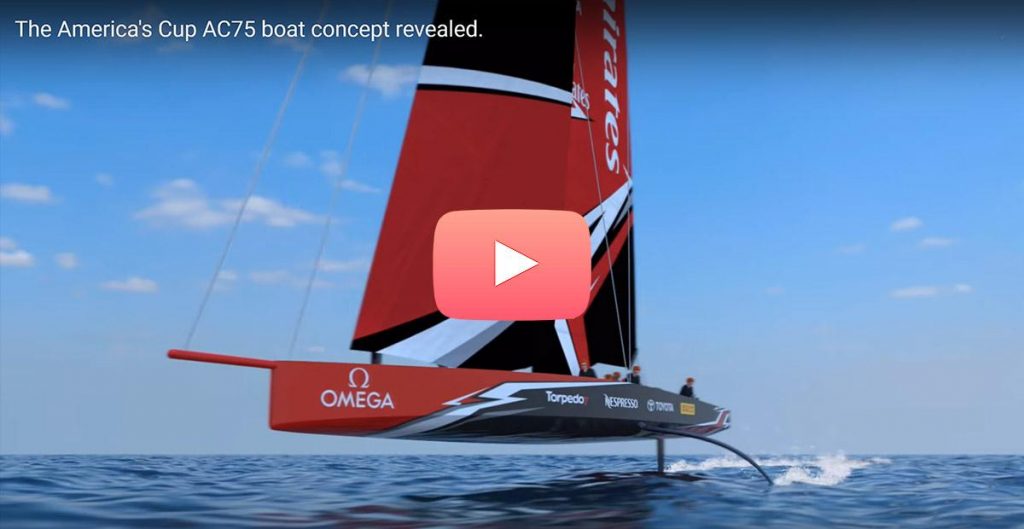
Here is the America’s Cup Class AC75 boat concept

The concept of the AC75 , the class of high-performance monohull racing yachts to be sailed in the 36th America’s Cup , has finally been revealed.
Compared with the previous editions managed by Alinghi and Oracle teams, this new concept marks an exciting new era in America’s Cup racing. However, what doesn’t change is the fully foiling catamarans’ ability to fly on the water , a feature that was already present on board the AC50 yachts.
As already announced during the presentation of the Protocol for the next America’s Cup, the concept of the new fully foiling monohull yachts equipped with canting foils has been unveiled before the end of November.
The choice of a monohull has been already announced by the two main players on the ground. Patrizio Bertelli, patron of Prada , launched the first challenge for the next America’s Cup with the Circolo della vela Sicilia , and as such became Challenger of Record and earned the power to decide the rules together with the Royal New Zealand Yacht Squadron . The abandonment of multihulls and the subsequent return to monohulls was necessary to enable the fashion entrepreneur to join a new challenge. The choice was strongly supported by Grant Dalton, Chief Executive Officer of Emirates Team New Zealand , maybe even more convinced of this change of course.
Monohull and high-performance, the new racing yachts demand highly competent sailors. Sailing cyclists disappear and grinders come back with more “normal” foresails. “Anyway, they will be faster than the AC50 catamarans both upwind and downwind “, claimed the authoritative Kiwi sailing’s representative.
Foils seems to be the most striking novelty. The concept is totally different from what we are used to see on the Imoca 60 yachts , the only class of racing boats that is actually able to fly over the water. Unlike ocean monohulls where twin foils have a single shaped blade, the AC75 yachts feature two canting foils of over 5 meters equipped with a curved shaft and a long terminal T-section.
The central bulb disappears and even the helm takes on a T layout. This way, the hull will be raised out of the water , like the Moth or old AC50 yachts, in order to reduce the sudden “jumps” of the Imoca 60 yachts.
The foils are set in various positions depending on the angle of attack and manoeuvring requirements. In normal sailing mode, the leeward foil will be in the water to provide lift and the windward foil provides righting assistance. Both foils can be employed for maximum stability in manoeuvres and difficult conditions. Furthermore, foils are planned to be self-righting in the event of a capsize.
Further details will be unveiled at the end of March 2018, when the complete class rules will be released. What seems to be certain is a definitive goodbye to rigid wings while the mainsail might be inflatable. The new hull design will be open and the yachts may have soft sails, including a Code 0 for light winds crossovers.
This way, both the yachts and the Cup are expected to enter a new revolutionary era. ” This Cup is an important step towards the future: the concept of the new AC75 Class will open new horizons for racing yachts which, in the next future, may also extend to cruising “, Bertelli stated.
Leave a Reply Cancel reply
Your email address will not be published.
Save my name, email, and website in this browser for the next time I comment.
You might be interested in
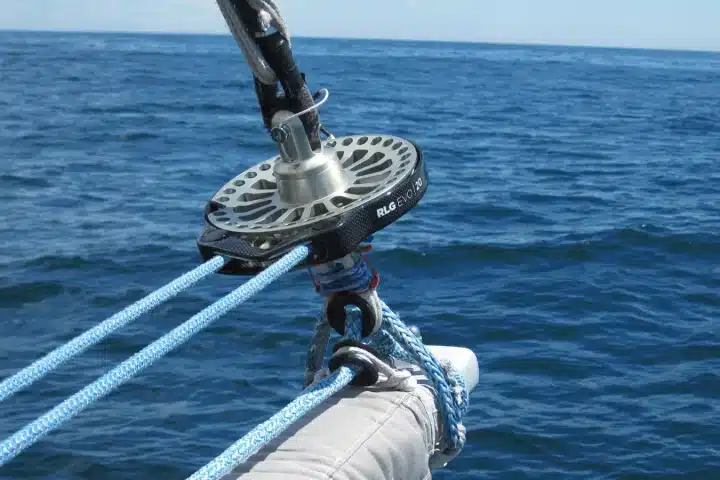
Bamar furlers withstand the most extreme regattas
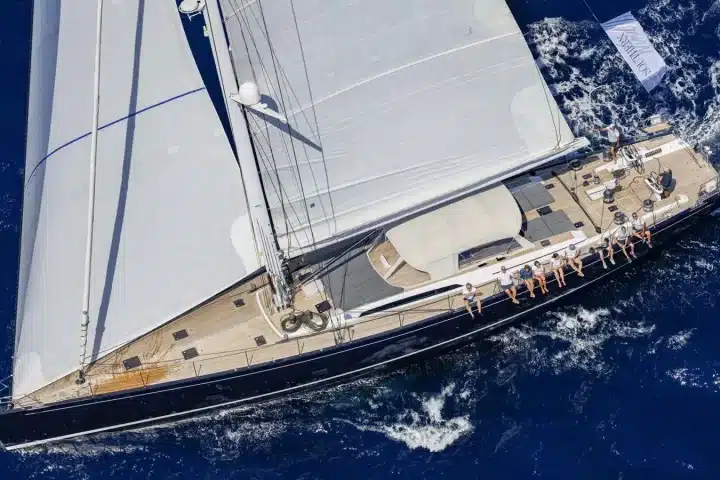
CAPE ARROW is for sale: price and where to see her
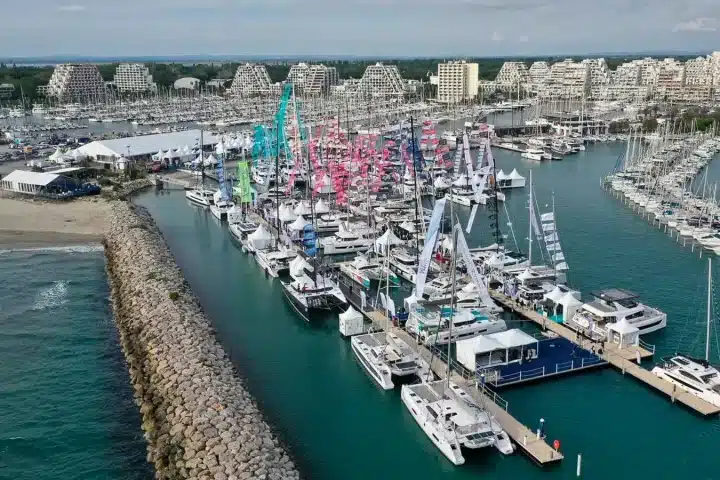
International Multihull Show 2024: big multihulls take center stage in La Grande Motte
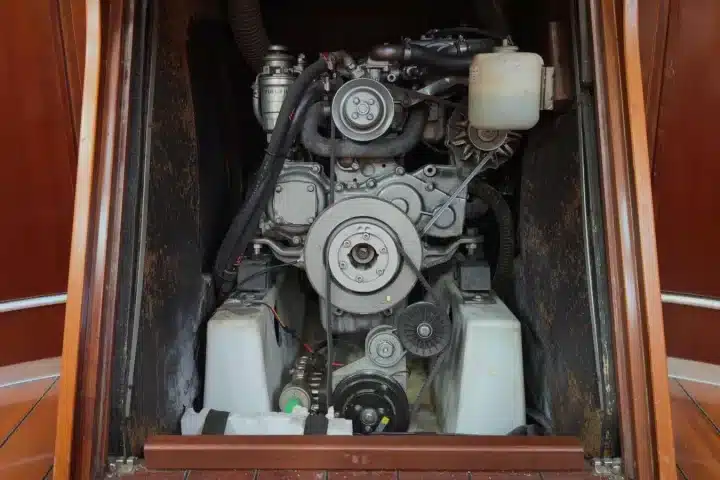
Boat Engine Maintenance: complete guide and useful tips for DIY
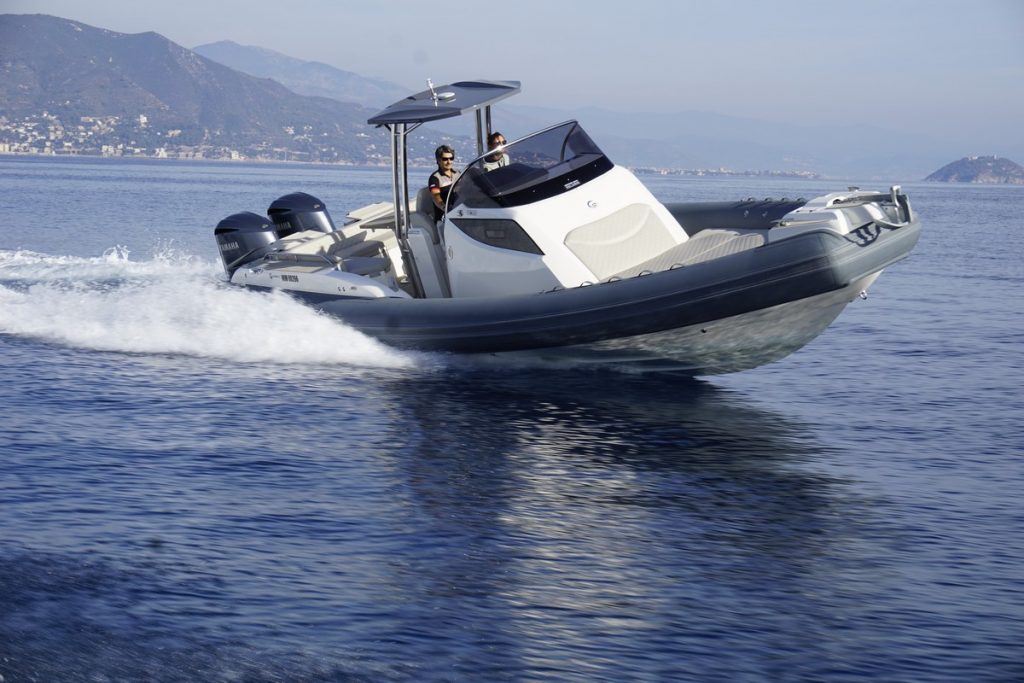
On Test. Capelli Tempest 38 and Yamaha 350hp outboard
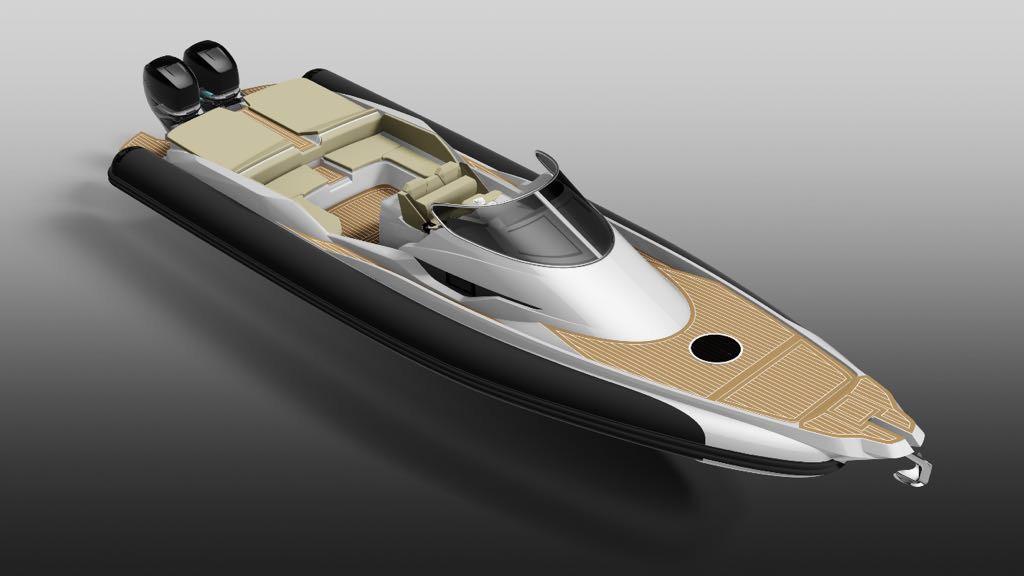
Nuova Jolly presents two world premières in Paris: the Prince 38 Sport Cabin and the NJ 700

To provide the best experiences, we and our partners use technologies like cookies to store and/or access device information. Consenting to these technologies will allow us and our partners to process personal data such as browsing behavior or unique IDs on this site and show (non-) personalized ads. Not consenting or withdrawing consent, may adversely affect certain features and functions.
Click below to consent to the above or make granular choices. Your choices will be applied to this site only. You can change your settings at any time, including withdrawing your consent, by using the toggles on the Cookie Policy, or by clicking on the manage consent button at the bottom of the screen.
Subscribe For Latest Updates
Sign up to receive the best of Yachting News, sea trials, boat review and world premieres .
The only ADVERTISING FREE newsletter

- CLASSIFIEDS
- NEWSLETTERS
- SUBMIT NEWS

America's Cup - Dan Bernasconi explains the foiling AC75 - Part 1
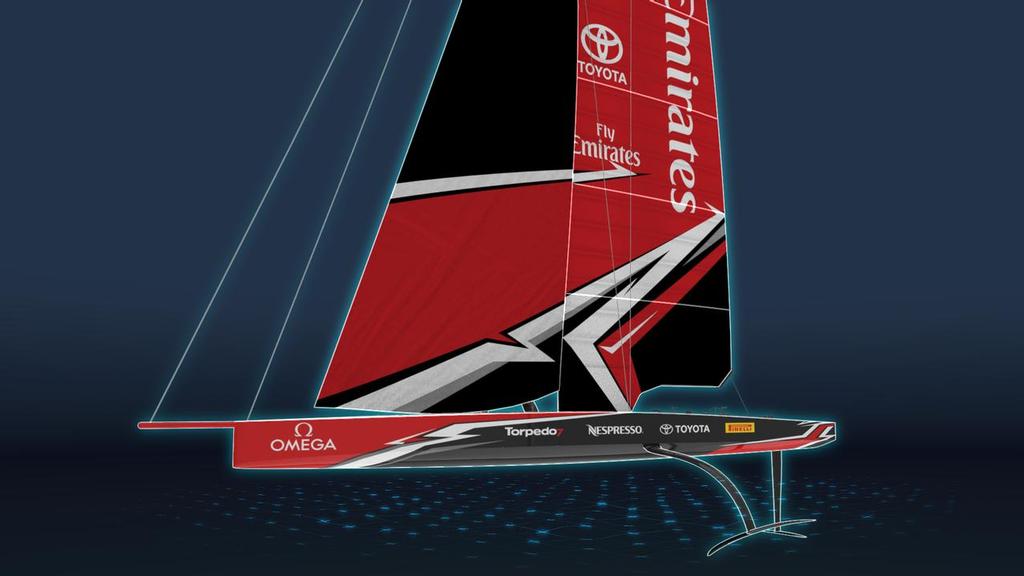
Related Articles
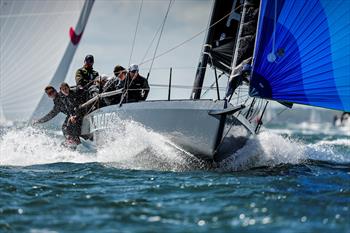
- AROUND THE SAILING WORLD
- BOAT OF THE YEAR
- Email Newsletters
- Best Marine Electronics & Technology
- America’s Cup
- St. Petersburg
- Caribbean Championship
- Boating Safety

The Foiling AC75
The mechatronics required to move the A75’s foils deliver precision handling and speed, and while they may look basic in form, their execution is anything but standard.
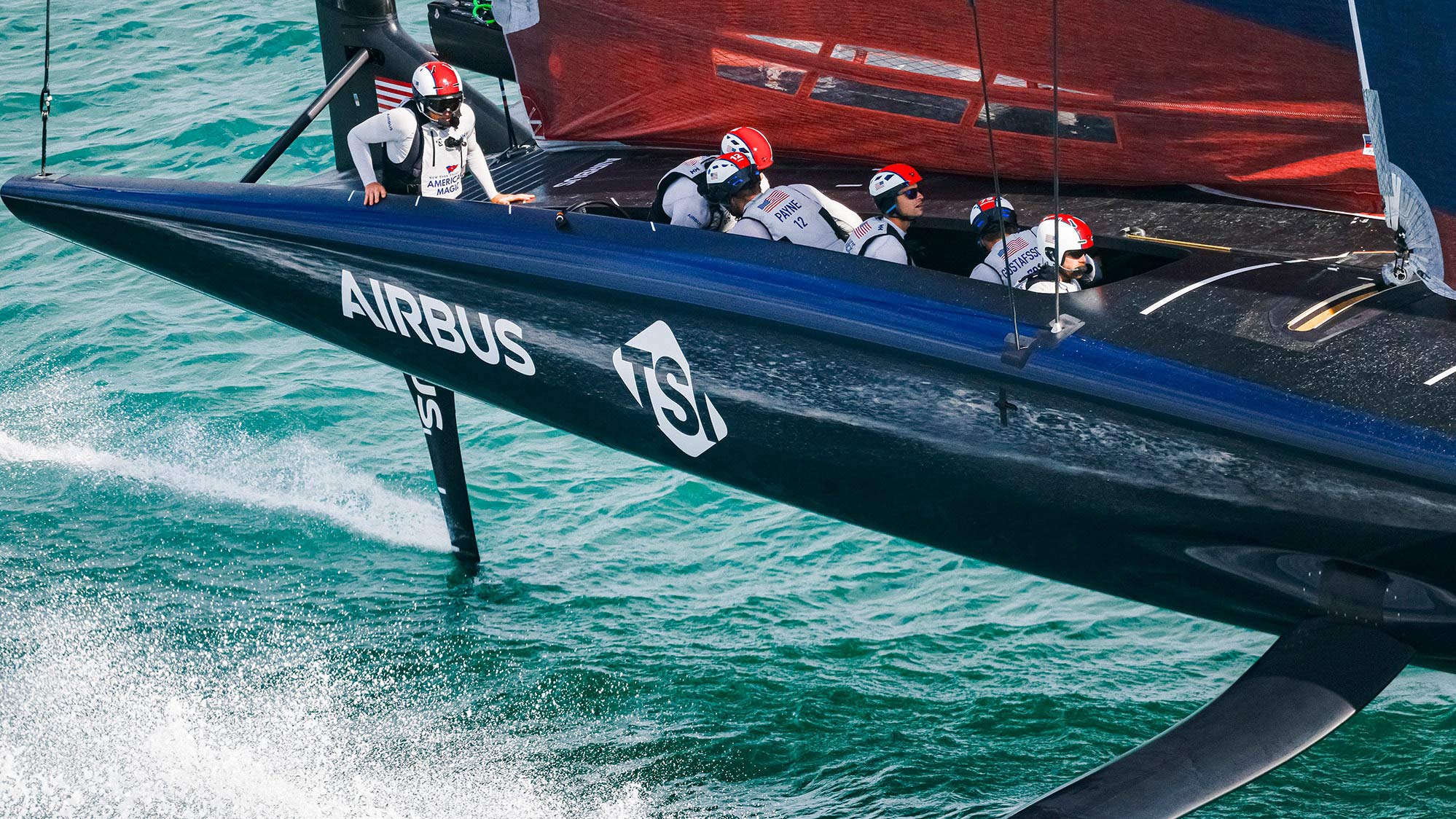
The physics of a foiling AC75 are as simple as they are complex, but envision a large windsurfing board with towering sails; there is no heavy keel to help keep it upright like a traditional sailboat. Wind blowing across the sails is the energy that essentially propels the boat forward while also making it lean over onto its side. Counteracting that heeling force on the AC75 is the boat’s subsurface horizontal foil, adjustable wings that provide lift for takeoff and steady flight.
On the opposite of the hull is the other foil arm, suspended by a massive hydraulic ram inside the boat. It’s weight helps to keep the boat balanced and upright while underway. When the boat tacks or jibes, battery-driven hydraulic rams push one foil underwater during the turn and then pulls the opposite into its up position.
Touchdowns are slow and, from what is known, take-off speed is king. Maneuverability comes next.
Under the rules of the regatta, all AC75s must meet certain dimension restrictions (length, width, weight, etc.), but the overall hull shape is left to the design team’s vision of what’s fast. There was noticeable variety in each team’s first-generation boats, common traits appeared with the second-generation designs: namely in the form of an underbody appendage that is said to capture airflow beneath the boat when foiling. Once a boat is foiling, however, the hull becomes an aerodynamic fuselage to carry the sailors controlling the boat.
Foil designs are open to development as well and that’s where the experts say the Cup will be won or lost. Teams are limited in the number of foil wings they can build for competition, but do have wide latitude to reshape them during the competition. Different wing profiles produce different results: larger wing foils get earlier liftoff in lighter winds (6.5 knots is the minimum required for racing), but come with drag. At the top of the wind range (23 knots maximum), smaller foil wings can and will be used, but here the tradeoff is speed versus control and maneuverability. The wings also have adjustable flaps and the internal mechanics of these adjustments are highly protected intellectual property.
Inside the AC75’s hull is an intricate web of hydraulic pumps, tubes, valves and rams that allow the sailors to make micro adjustments, using programmable logic controllers to manipulate the sails and foils on demand. Of the 11 crew members onboard, the division of labor is clear: the helmsman essentially steers the boat around the racecourse. The mainsail trimmer controls the three-dimensional shape of the mast and the mainsail, using a handheld controller with toggles and buttons to manipulate the sails and effectively balance the boat through every gust and lull in the wind.
The third critical crewmember in this modern-day afterguard is called the “flight controller” who uses custom controllers and software to move the big foil arms up and down, to alter their angles, and adjust the foil flaps. Essentially, these three individuals fly the boat, which leaves the eight others as pure muscle, powering the boat’s hungry hydraulic systems every time some presses a button. Nothing happens on these boats without hydraulic pressure, which is why the “grinders” will be heads-down, hammering away for 60-minute stretches on their pedestals.
- length: 75 feet – 22,86m
- max beam (width): 5m
- mast: 26,5 m
- sail area: mainsail/soft wing 145m2 – jib 80m2 – code zero 180m2
- weight: 6500 kg
- crew: 11 people
- crew weight: 990 kg
- ideal grinder weight: 105 kg
- expected speed: upwind: from 25 to 38 knots downwind: between 32 and 50 knots (one knot = 1 mile per hour = 1,852m per hour)
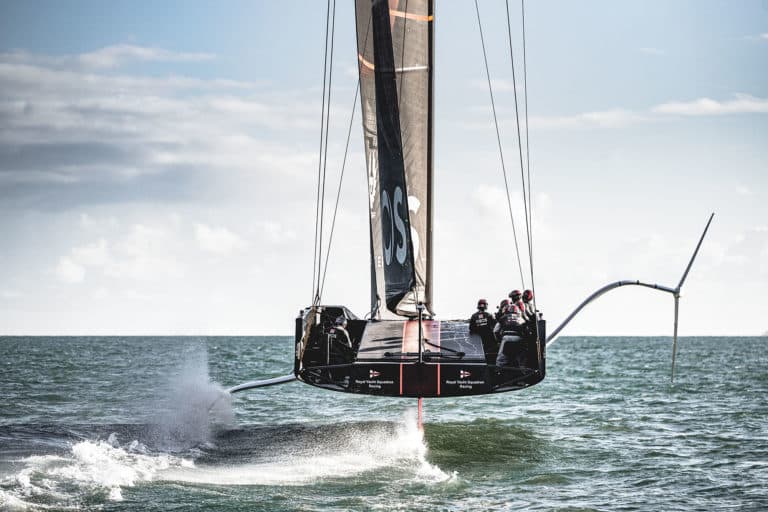
Exploring The Generation 1 America’s Cup 75
Naval architect Scott Ferguson examines the first-generation AC75 designs.
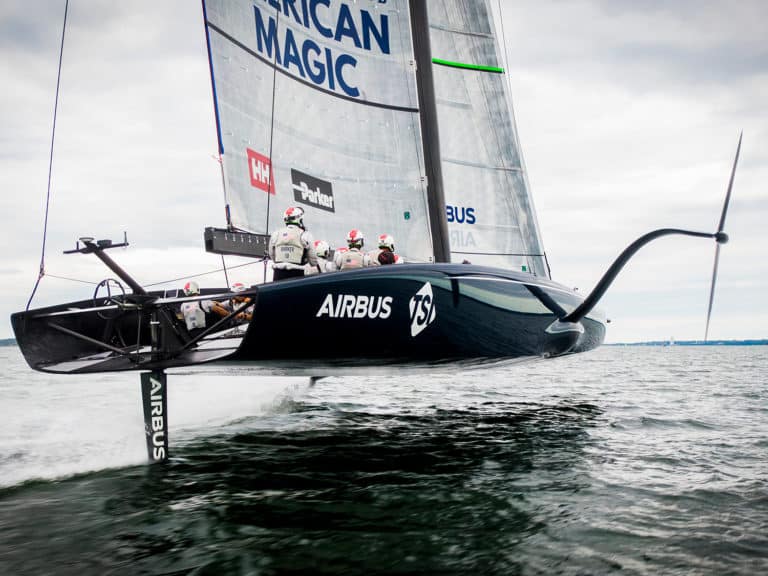
American Magic’s Defiant Unveiled
America’s Cup Challenger American Magic unveils its AC75 and we go in for a closer look.
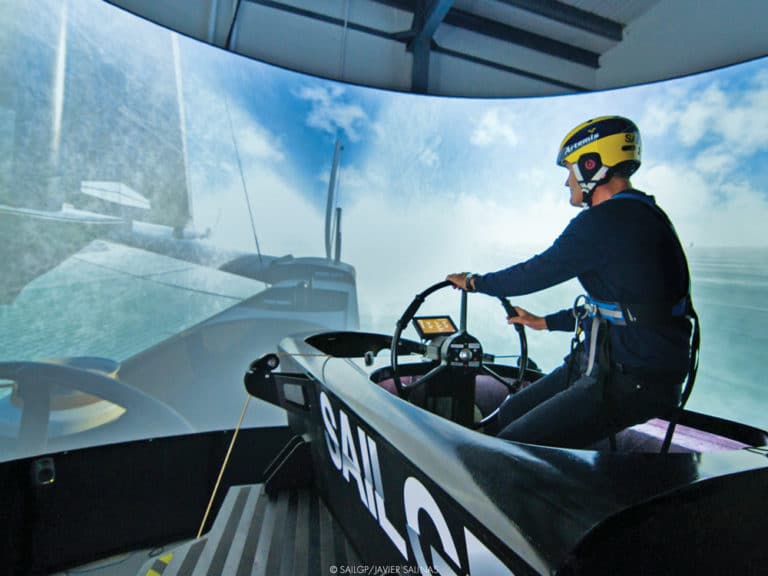
The Cup’s Pro-Sailing Spinoff Takes Off
A new sailing circuit is launched, with a turbocharged fleet of America’s Cup foiling catamarans and a pool of pro sailors itching to get air time.
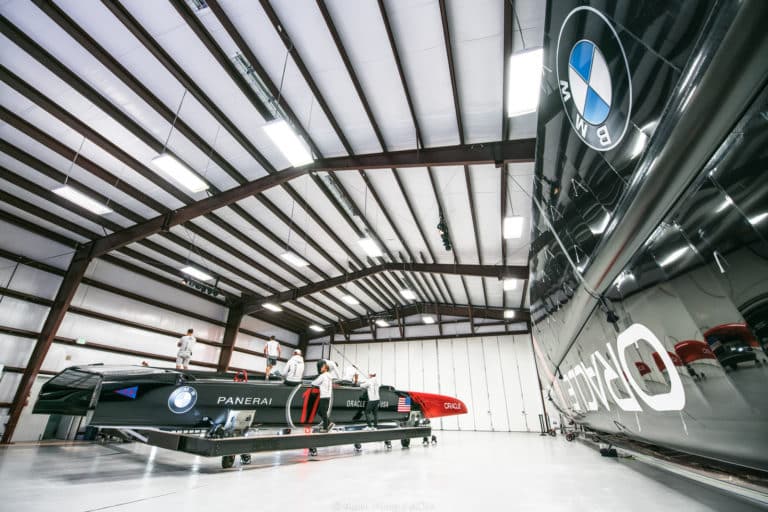

The Tech Behind the America’s Cup
Experts have drilled into new areas as never before for the 35th America’s Cup. While the boats might look alike, the hidden differences are critical.

Second U.S. America’s Cup Challenger Goes Live
Stars & Stripes Team USA, American flagged Challenger for the 36th America’s Cup, today released additional details outlining their boat build and design process. This
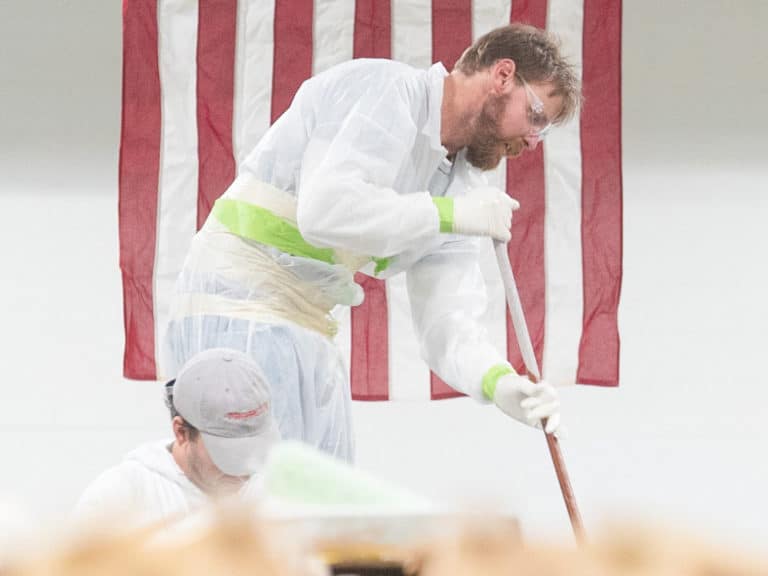
Holland in the House
At some point in the summer of 2019, Composite Builders will open the big doors on the backside of its beige 30,000 square-foot fabrication lair
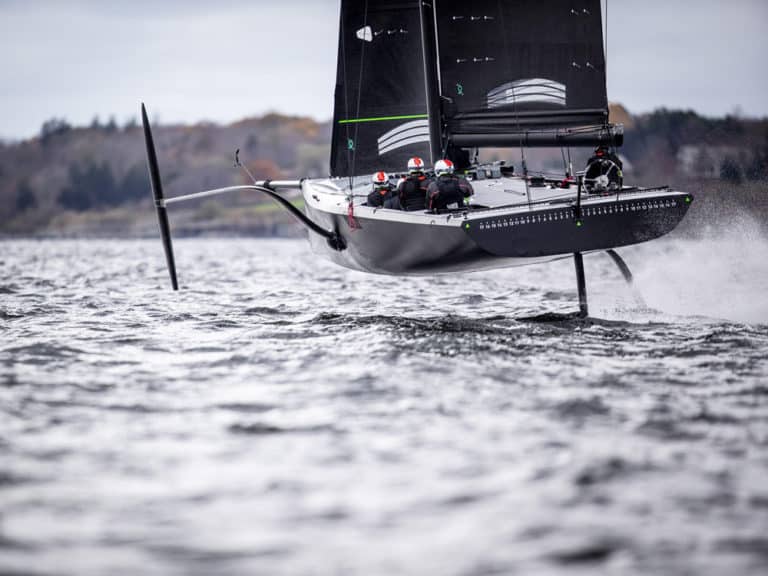
Confirmed Flight for American Magic
With a productive first session on its test boat, the American Magic challenger confirms it can fly, and is quickly advancing toward the launch of its first AC75.
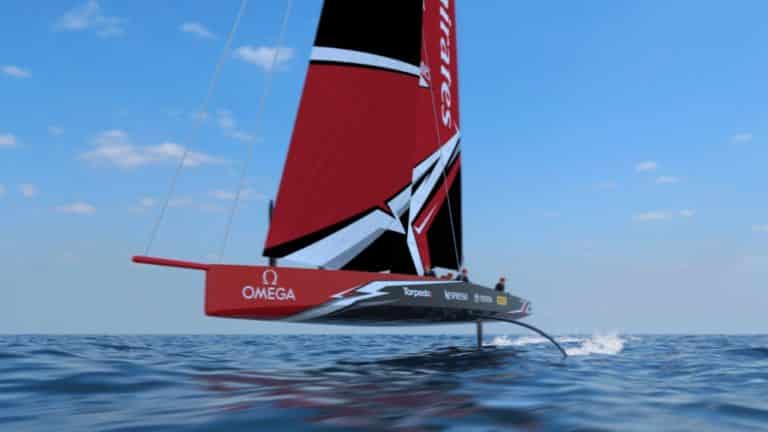
America’s Cup 36 Monohull Revealed
An exciting new era in America’s Cup racing has been unveiled today as the concept for the AC75, to be sailed in the 36th America’s Cup is released.

- Digital Edition
- Customer Service
- Privacy Policy
- Cruising World
- Sailing World
- Salt Water Sportsman
- Sport Fishing
- Wakeboarding

America’s Cup: AC75, Designed to Fly
Published on August 2nd, 2020 by Editor -->
It was August 2012 when the sailing world was turned upside down by a 72-foot catamaran flying in the Hauraki Gulf. Emirates Team New Zealand had brought foiling to the America’s Cup and changed the face of top-level yacht racing forever.
Since then the increase in performance for America’s Cup boats has been greater than at any point in the 170-year history of the event.
Six years later, in 2018, the publication of the AC75 Class rule marked the beginning of a new sailing era. Nowadays foils are commonplace, but the engineering and sailing techniques needed to get the AC75 to fly are completely different from anything seen before.
To start with, the AC75 is big – 75-feet long and 16-feet wide – but, it’s also light, which is crucial, because the AC75 is designed to fly. It’s also different – rather than a keel, a brand new concept keeps it standing. Foil Cant Arms move under, or outside, the boat to provide the leverage it needs to stay upright.

Some parts of the boat are supplied or specified – the mast tube, rigging, foil-cant arms and their hydraulics are all stock components. But, there are still plenty of areas that designers can experiment with to find a race-winning edge.
Video uploaded Aug 2, 2020.
Source: America’s Cup
Details: www.americascup.com
36th America’s Cup In addition to Challenges from Italy, USA, and Great Britain that were accepted during the initial entry period (January 1 to June 30, 2018), eight additional Notices of Challenge were received by the late entry deadline on November 30, 2018. Of those eight submittals, entries from Malta, USA, and the Netherlands were also accepted. Here’s the list:
Defender: • Emirates Team New Zealand (NZL)
Challengers: • Luna Rossa (ITA) – Challenger of Record • American Magic (USA) • INEOS Team UK (GBR) • Malta Altus Challenge (MLT) – WITHDRAW • Stars + Stripes Team USA (USA) • DutchSail (NED) – WITHDRAW
Of the three late entries, only Stars+Stripes USA remains committed , however, it is unclear what entry payments have been made, nor is there knowledge of a boat being actively built or sailing team assembled.
Key America’s Cup dates: ✔ September 28, 2017: 36th America’s Cup Protocol released ✔ November 30, 2017: AC75 Class concepts released to key stakeholders ✔ January 1, 2018: Entries for Challengers open ✔ March 31, 2018: AC75 Class Rule published ✔ June 30, 2018: Entries for Challengers close ✔ August 31, 2018: Location of the America’s Cup Match and The PRADA Cup confirmed ✔ August 31, 2018: Specific race course area confirmed ✔ November 30, 2018: Late entries deadline ✔ March 31, 2019: Boat 1 can be launched ( DELAYED ) ✔ 2nd half of 2019: 2 x America’s Cup World Series events ( CANCELLED ) ✔ October 1, 2019: US$1million late entry fee deadline ( NOT KNOWN ) ✔ February 1, 2020: Boat 2 can be launched ( DELAYED ) ✔ April 23-26, 2020: First (1/3) America’s Cup World Series event in Cagliari, Sardinia ( CANCELLED ) ✔ June 4-7, 2020: Second (2/3) America’s Cup World Series event in Portsmouth, England ( CANCELLED ) • December 17-20, 2020: Third (3/3) America’s Cup World Series event in Auckland, New Zealand • January 15-February 22, 2021: The PRADA Cup Challenger Selection Series • March 6-15, 2021: The America’s Cup Match
Youth America’s Cup Competition • February 18-23, 2021 • March 1-5, 2021 • March 8-12, 2021
AC75 launch dates: September 6 – Emirates Team New Zealand (NZL), Boat 1 September 10 – American Magic (USA), Boat 1; actual launch date earlier but not released October 2 – Luna Rossa (ITA), Boat 1 October 4 – INEOS Team UK (GBR), Boat 1

Tags: AC75 , America's Cup
Related Posts

Hydraulics: key to the Cup? →
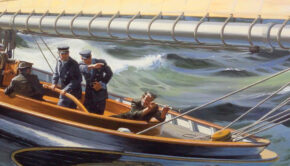
The Last Days of the Schooner America →

America’s Cup: Half the crew will pedal →
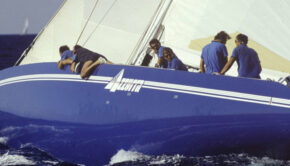
Italy and the America’s Cup →
© 2024 Scuttlebutt Sailing News. Inbox Communications, Inc. All Rights Reserved. made by VSSL Agency .
- Privacy Statement
- Advertise With Us
Get Your Sailing News Fix!
Your download by email.
- Your Name...
- Your Email... *
- Name This field is for validation purposes and should be left unchanged.

- Nautic Shows
- America’s Cup
- Classic Yachts
- Motor Yachts
- Sailing Yachts
- Superyachts
- Yachts News
- Destinations
- Yacht Clubs
- Boat Racing
- Meta Yachts

Emirates Team New Zealand has followed a predictable path with the “announcement” that the 2021 America’s Cup champion “is back in the shed and will be back out foiling around the harbor with one or two new configurations in due course.”
The expected move was confirmed by the team, with a photo posted on social media with the winning AC75 sitting in the team’s Wynyard Point Base alongside the wingless test boat LEQ12, which has 17 days of test sailing in its logbook.
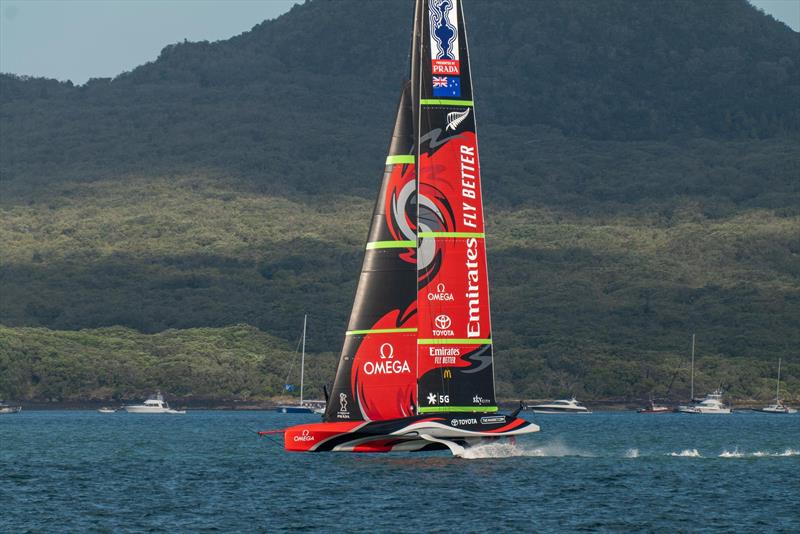
The announcement follows a familiar path to the 2007, 2013, 2017 and 2021 America’s Cup campaigns, where an effective two-boat program has been run, regardless of the intention of the America’s Cup rules at the time.
In 2007, it was still permitted to build multiple America’s Cup class yachts and run what was known as a two-boat program. In pre-simulator days, it involved months of testing one configuration against another before doing a rinse-and-repeat cycle on the other boat to verify a speed or sailing angle gain.
In 2013, following a change of America’s Cup Class, the team built a full-size AC72 wingsailed catamaran, which was fitted with foils – something not contemplated by the rule-makers, which resulted in complaints to the America’s Jury by the then Defender, Oracle Team USA and the Challenger of Record from Sweden.
Their complaint was dismissed. However, the Kiwis had prematurely revealed their hand, and the other three teams followed suit.
In 2017 Emirates Team NZ found a neat way around the rules by developing a test platform using AC45 hulls but with an almost metre-long rudder gantry, which gave the team the foiling geometry of an AC50 which was the America’s Cup Class for the 2017 Cup in Bermuda.
That move gave the Kiwi team a six-month head start with AC50s on the other teams, which were allowed to launch only one AC50 wingsailed and now foiling catamarans. The Kiwis used the advantage of full-size AC50 components on the test boat, some of which were transferred across to the race boat.
It was a similar story in 2021, following yet another change in America’s Cup Class, two AC75 boats were permitted. Te Aihe (now used as a trial horse by the Alinghi Red Bull Racing team) was developed, with many of the systems transferred across to the raceboat, Te Rehutai, which went on to win the 2021 America’s Cup.
The advantage of transferring tested and developed systems from a development boat across to the race boat is that it saves a lot of debugging and allows teams to put their efforts into developing new gear and systems.
The practice of using a top yacht from the previous Cup as a trial horse stems back to the 1956 America’s Cup, when the Match was sailed in 12 metres, and it is possible, and permitted, to test in full size.
Under the current America’s Cup rules, Emirates Team New Zealand can’t sail Te Rehutai against their AC75 raceboat, but ashore they can sail it against the simulator computer. The latest performance data from Te Rehutai can also be used as input into the AI-based system developed for the 2021 Cup, which will likely be extended.
On the water, they can sail against their LEQ12 development boat, which is a turbo-charged AC40 hull taken out of one-design class configuration.
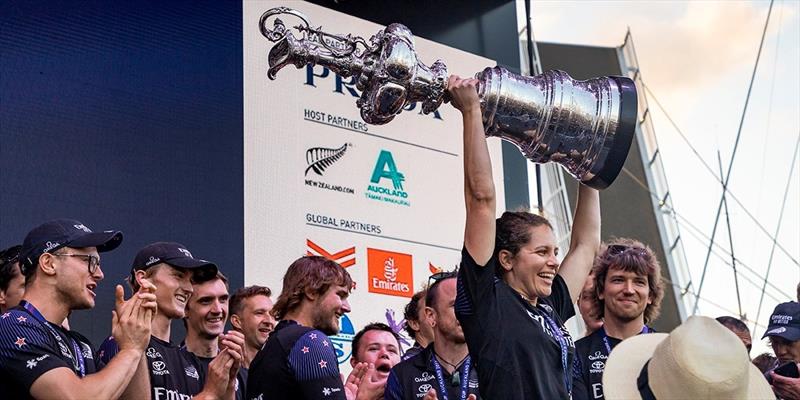
ETNZ, who designed the AC40, took the option of designing it as a step-on from Te Rehutai, and to some advantage from it being of the same design genre, rather than producing a more radical boat.
The recon team reports that the LEQ12 is nearly as quick despite being almost half the size of an AC75. However, the primary use of Te Rehutai will be to measure its performance data against the Version 1 AC75 configuration to which it was built and then check the gains arising from changes.
The Version 2 of the AC75 class rule has several changes to the Version 1 AC75 used for the 2021 America’s Cup, and Te Rehutai will be a full-sized test bed for some of the Version 2 rule features.
One of the changes will be the testing of the use of cyclors, continuing the work of then-rookie performance engineer Elise Beavis, who was assigned to the secret project soon after she joined the team in 2015 – straight from the University of Auckland with a Bachelor of Engineering degree with First Class Honours.
While cyclors were not illegal in the 2017 America’s Cup, other teams did not move on them for various reasons. By using cyclors, Emirates Team New Zealand made a significant gain in power and speed of hydraulic pressure replacement.
The Kiwis virtually confirmed their direction of travel for the 2024 Cup with the announcement at the end of January of triple Olympic Gold medalist rower Hamish Bond and three others with strong cycling, rowing and multi-sport backgrounds. They joined a team of returning cyclors/grinders – part of the winning team from the 2017 and 2021 America’s Cups. Bond’s last role was as the stroke of the Gold medal-winning Eight at Tokyo2020. Between Olympics, he switched to cycling, winning a Bronze medal in the 2018 Commonwealth Games road time trial.
Pedal power was not allowed in the Protocol negotiated between the Royal New Zealand Yacht Squadron (ETNZ) and the then Challenger of Record Circolo Della Vella Sicilia (Luna Rossa). However, it is now legal in the current Protocol, which was negotiated between RNZYS and the AC37 Challenger of Record, Royal Yacht Squadron (INEOS Britannia).
The bottom line is that ETNZ will enjoy the benefit of applying learning from a previous campaign. The other teams are starting with a blank piece of paper regarding the application of leg-powered technology in the America’s Cup.
New York Yacht Club’s American Magic does have a cycling partner in SRAM – one of the world’s most innovative bicycle component manufacturers and has fitted cycling stations into their test AC75 – Patriot – the team’s challenger from the 2021 America’s Cup.
There were no published shots of the cycling systems used in the 2017 Cup. So far in the 2024 Cup, despite the many cockpit shots of American Magic’s cockpit, there is nothing in the Reconnaissance File System (RFS) that shows Patriot’s cycling system. The black carbon fibre backdrop of the cockpit interior provides a very legal disguise.
Another difference in the Version 2 AC75 Class Rule, which the Kiwis will need to verify full size, is the effect of the reduction of boat weight by around 900kg.
Gains from putting the AC75 on a weight reduction program are achieved by several means, including removing the Code Zero foresail and bowsprit. (That effectively reduces the AC75’s length from 75ft to 69ft).
Another is the reduction in crew numbers from 11 sailing crew to eight, who are expected to be split across two cockpits. Part of the testing will be whether those crew remain at their allocated station, as in the AC40s. Or cross to the windward hull and add to the righting moment, as they did in the 2021 America’s Cup cycle.
Under AC75 Version 2, the total crew weight is set at 700kg for eight crew members, down from the 990kgs total permitted under Version 1. That, in turn, equates to a slight reduction in average crew weight from 90kgs to 87.5kgs.
The wing foils are permitted to be bigger under Version 2, and the overall depth of both the standard supplied arms and wing foils to be 200mm deeper.
The weight reduction and increase in wing size are expected to reduce the difficulty of AC75s to get foiling in minimum racing winds strengths while keeping speed-sapping drag to a minimum.
Part of the investigations with cyclors on the upgraded AC75 will be around the weight and configuration of systems used and making those as efficient as possible.
In the 2017 Cup, one primary cyclor was used, Simon van Velthooven, always at the front of the AC50 peloton and joined by two or three others. One benefit of cyclists over grinders is that a flight controller like Blair Tuke can provide leg power if required. How this will work out in the AC75 needs to be tested full size. Cycling stations are not fitted into the 39ft LEQ12.
Other areas of full-size investigation will include a new jib sheeting system now that self-tacking jibs are permitted. The British team have been testing a very elegant solution to the jib sheeting function.
Similarly with mainsheet systems – in the 2021 Cup, the Kiwis were the first to dispense with the traditional mainboom in favour of a boomless clew sheeted, hydraulic control of the double-skinned mainsail. The other teams have emulated that concept on their AC75 or LEQ12 (40ft) test boats.
What the Kiwis have up their sleeve will be watched closely by the other teams, which in this Cup cycle have to watch through the lens of the AC37 Joint Reconnaissance team. Individual team espionage units are now not permitted to operate on the water or land, aside from casual photos taken from onshore by a mobile phone.
Using high-powered binoculars by shore-based team spies is quite legal while a team is rigging and launching. Based on these observations or an analysis of the daily content in the RFS, a team spy can request specific shots from the local recon team member.
The pressure is expected to go onto the local recon team, with the Challengers expected to sign off on their final raceboat designs in a month or two.
In the days when there was little restriction on recon teams’ activities, some very aggressive RIB driving was commonplace as the spies jostled to get into the best position to shoot images and report on new developments. It was not unusual to see crews following team New Zealand and on the phone back to their base in Europe or USA during a sailing session. Obviously, with current technology, it would have been easy to send live images back during the session and receive further shooting viewing instructions, speeding up the efficiency of the reconnaissance process.
Another recon team issue will be the quality of the boats supplied by the observed team. Several reports from the recon teams have mentioned that their RIBs could not keep pace with the AC40s/AC75 because of the yacht’s superior speed in an awkward sea state. Under the Technical Regulations, the recon boats must be capable of 45kts in flat water – however, this speed reduces significantly in a seaway, which is of little hindrance to the foiling yachts.
It remains to be seen if other teams also opt to re-launch first or second-generation AC75s.
American Magic have decommissioned their second generation AC75 Patriot, which was partially upgraded to the suit Version 2 of the AC75 Class Rule. They have over 40 days sailing in their log book – mostly very useful speed training in flat water.
The Challenger of Record, INEOS Britannia, have donated their AC75 2021 Prada Cup finalist to the Cowes Museum.
ETNZ’s modifications to Te Rehutai will be closely followed in the coming weeks.
Stay tuned.
- Americas Cup
- Emirates Team New Zealand
RELATED ARTICLES
A sweltering sunday: light winds and looming storms on the red sea, alinghi red bull racing embracing the spirit of dedication, luna rossa’s ac75 departs persico marine en route to cagliari, alinghi red bull racing takes advantage of training opportunities in jeddah, barcelona’s splendor and perfect sailing conditions.

Subscribe to our newsletter
To be updated with all the latest news, offers and special announcements.
LATEST ARTICLES
Sailgp’s christchurch return: race times and maps revealed as excitement grows, editor picks, canadian beau lake introduces the tahoe ’14 and lugano ’14 electric runabouts, underwater adventure and exploration with deepflight’s super falcon 3s, driving performance on land and on water: 41′ amg carbon edition, popular posts, young designer of the year 2022: ioana valentina corcodel reveals 65m ophelia concept, mirabaud sailing video of the century: celebrating 2 decades of passion, superyacht the flying fox seized in the dominican republic, popular category.
- Regatta 805
- America's Cup 380
- Motor Yachts 260
- Boating 215
- Superyachts 181
- Sailing 176
- Yachts News 173
- Sailing Yachts 162

Road to the America’s Cup podcast episode 2: How the AC75 will fly
- October 10, 2019
In recent weeks we have seen the first AC75s start to fly, but the engineering and sailing techniques needed to get these new monohulls to foil are very different to the catamarans of the previous Cup cycles

Flaps on the T-foils is a big change for this Cup. Photo: Harry KH / Ineos Team UK
America’s Cup teams first flew in San Francisco in 2013. The use of hydrofoils to lift the AC72 catamarans out of the water was a Team New Zealand innovation, despite a class rule that was written to keep the boats in the water. This time around the AC75 rule definitely intends us to fly, and the foils will be a focus for the team right from the launch.
“The hydrofoils on a Cup boat work exactly as on an aircraft wing: you have the asymmetric flow around the wing or foil, which creates a pressure difference. That then generates a force that’s trying to equalise the difference. The force lifts the plane off the ground – or the boat out of the water, in our case,” explained Ben Ainslie.
The central innovation in those early days was shaping the daggerboard into a foil that could provide both lift and leeway resistance. The problem was how to control the lift sufficiently well to enable stable flight. The AC72 design rules forbid any part of the foil to move independently, so the Kiwis couldn’t use flaps to control lift. These are the adjustable trailing edges, just as a pilot uses to control the lift generated by an aircraft wing.
Enjoyed this podcast? Please leave us a rating and/or review on SoundCloud , iTunes or Stitcher .
Trailing edge
The design rule for the AC50s in Bermuda also forbade the use of flaps, but this time around, they’re allowed. This is one of the biggest differences with the AC75 rule; it has ushered in a new era in foiling Cup-boats by specifically allowing flaps on the T-shaped foils.
“We will have direct control of the flap on the trailing edge of the T-foil,” explained Ainslie. “Moving the flap down will create more lift and more drag, but the lift is good for creating take-off. Moving the flap up to come more in line with the rest of the foil will reduce the lift and drag, which is then good for higher speed. It’s finding that trade-off really.”
The flap is a much more efficient way to control lift than moving the whole foil, and it’s no surprise that it’s been allowed for the AC75. Now we’re back to racing monohulls, which have a lot less stability at rest and slow speeds when the foils are not supplying any righting moment. The control systems will need to be more efficient to fly these boats compared to the AC50.
“It’s [the AC75] got some form stability from the hull,” said Ainslie, “but after that it’s reliant on the lift from the wings and the foil arm to give the boat the righting moment. We think – we hope – we’ve got a good idea of how this is going to play out and what sort of speed we need to create righting moment and ultimately to take-off.
“Without a lead keel you’ve got to be very, very careful about how you power up the boat, how you create the speed, what angles you sail to create the speed. The simulator has been really critical to developing the techniques, both for the designers and for the sailors,” explains Ainslie.
“What sorts of forces do we need to get the boat flying in the first place? What techniques do we employ? What settings do we employ? We can then incorporate that [information] into our test programme and flight programme for getting RB1, as we call the first AC75, out on the water and sailing and foiling.
Article continues below…

America’s Cup challenger Malta Altus withdraws as $1m fees deadline draws in
An America’s Cup challenger from Malta has officially pulled out of the 2021 America’s Cup in New Zealand. Malta Altus…

Road to the America’s Cup podcast episode 1: Imagining the AC75
There is no doubt that the AC75 is a remarkable boat; a monohull designed to fly, engineered to reach speeds…
“We’ve seen through simulation and the test boat that when you start off you’re very gingerly trimming in the sails trying to get the right heel on the boat to create speed. Then as the righting moment kicks in you’ve got the power, you trim on, you lift out of the water and then you’re up to speed and the boat is more locked in.
“In that sense it will be quite a neat challenge for the sailors out on the water. Very similar to the high-performance dinghies you see. I think our sailors are very well prepared for that. Obviously, time on the water will be critical, as will time in the simulator, so that we get as much time together as a group and really understand how we get maximum performance from these boats.”
About the author
Ben Ainslie is the most successful Olympic sailor of all time, and Team Principal of the British America’s Cup challenger. INEOS Team UK will be challenging for the 36th America’s Cup in New Zealand in 2021. Each month he’ll be talking to Mark Chisnell about the innovations and technology behind the new AC75 foiling monohulls.
- Election 2024
- Entertainment
- Newsletters
- Photography
- AP Buyline Personal Finance
- Press Releases
- Israel-Hamas War
- Russia-Ukraine War
- Global elections
- Asia Pacific
- Latin America
- Middle East
- March Madness
- AP Top 25 Poll
- Movie reviews
- Book reviews
- Personal finance
- Financial Markets
- Business Highlights
- Financial wellness
- Artificial Intelligence
- Social Media
Russia accuses Ukraine of striking same Moscow building that was hit by drone days ago
Russian authorities early Tuesday accused Kyiv of another attack on Moscow and its surroundings with drones, one of which hit a building in the capital that was damaged by a drone just days ago in a similar attack early Sunday. (August 1)

Russia shells hospital in Ukraine’s Kherson

Russian drones strike buildings in Kharkiv
Investigators examine an area next to a damaged building in the “Moscow City” business district after a reported drone attack in Moscow, Russia, early Tuesday, Aug. 1, 2023. Ukrainian drones again targeted Moscow and its surroundings early Tuesday morning, the Russian military reported. Two of three launched were shot down outside Moscow, while one crashed into a skyscraper in the Moscow City business district, damaging the building’s facade. (AP Photo)
- Copy Link copied
Firefighters and a police officer stand next to a damaged building in the “Moscow City” business district after a reported drone attack in Moscow, Russia, early Tuesday, Aug. 1, 2023. Ukrainian drones again targeted Moscow and its surroundings early Tuesday morning, the Russian military reported. Two of three launched were shot down outside Moscow, while one crashed into a skyscraper in the Moscow City business district, damaging the building’s facade. (AP Photo)
A view of the damaged building is seen in the “Moscow City” business district after a reported drone attack in Moscow, Russia, early Tuesday, Aug. 1, 2023. Ukrainian drones again targeted Moscow and its surroundings early Tuesday morning, the Russian military reported. Two of three launched were shot down outside Moscow, while one crashed into a skyscraper in the Moscow City business district, damaging the building’s facade. (AP Photo)
Firefighters stand next to a damaged building in the “Moscow City” business district after a reported drone attack in Moscow, Russia, early Tuesday, Aug. 1, 2023. Ukrainian drones again targeted Moscow and its surroundings early Tuesday morning, the Russian military reported. Two of three launched were shot down outside Moscow, while one crashed into a skyscraper in the Moscow City business district, damaging the building’s facade.(AP Photo)
A man takes a photo of the damaged building in the “Moscow City” business district after a reported drone attack in Moscow, Russia, early Tuesday, Aug. 1, 2023. Ukrainian drones again targeted Moscow and its surroundings early Tuesday morning, the Russian military reported. Two of three launched were shot down outside Moscow, while one crashed into a skyscraper in the Moscow City business district, damaging the building’s facade.(AP Photo)
A view of the damaged building, centre, is seen in the “Moscow City” business district after a reported drone attack in Moscow, Russia, early Tuesday, Aug. 1, 2023. Ukrainian drones again targeted Moscow and its surroundings early Tuesday morning, the Russian military reported. Two of three launched were shot down outside Moscow, while one crashed into a skyscraper in the Moscow City business district, damaging the building’s facade. (AP Photo)
A view of the damaged building is seen in the “Moscow City” business district after a reported drone attack in Moscow, Russia, early Tuesday, Aug. 1, 2023. This building was already attacked by a drone two days ago. Ukrainian drones again targeted Moscow and its surroundings early Tuesday morning, the Russian military reported. Two of three launched were shot down outside Moscow, while one crashed into a skyscraper in the Moscow City business district, damaging the building’s facade. (AP Photo)
Investigators examine an area next to damaged building in the “Moscow City” business district after a reported drone attack in Moscow, Russia, early Tuesday, Aug. 1, 2023. Ukrainian drones again targeted Moscow and its surroundings early Tuesday morning, the Russian military reported. Two of three launched were shot down outside Moscow, while one crashed into a skyscraper in the Moscow City business district, damaging the building’s facade. (AP Photo)
TALLINN, Estonia (AP) — A drone attacked a skyscraper in central Moscow early Tuesday for the second time in around 48 hours, damaging the building’s facade and further underscoring the Russian capital’s vulnerability. Russian authorities accused Ukraine of staging the assault.
An adviser to Ukrainian President Volodymyr Zelenskyy tweeted that Moscow “is rapidly getting used to a full-fledged war,” without confirming or denying Kyiv’s involvement.
Russian officials have claimed that the repeated attacks on the capital region reflect failures in Ukraine’s counteroffensive to recapture Russian-occupied territory. Zelenskyy said over the weekend that “the war is gradually coming back to Russian territory,” but he stopped short of taking responsibility.
Russia’s Defense Ministry said it shot down two Ukrainian drones outside Moscow and jammed another, sending it crashing into a skyscraper and damaging the building’s facade. The attack happened in a business district of high-rise office buildings known as Moscow City, west of the Kremlin.
Moscow Mayor Sergei Sobyanin said the drone crashed into the same building that was damaged Sunday in a similar attack. IQ-Quarter, located 7.2 kilometers (4.5 miles) from the Kremlin, houses multiple government agencies, including the headquarters of the Ministry of Economic Development, the Ministry of Digital Development and Communications, and the Ministry of Industry and Trade.
The mayor said the attack on Tuesday did not result in any casualties.
It wasn’t clear why the same building was hit twice in a row. In both attacks, the Russian military said the drones that hit the skyscraper were jammed before crashing, which elicited questions from even the staunchest supporters of the Kremlin.
Margarita Simonyan, chief editor of the state-funded TV channel RT, said in a social media post that “a drone hitting the same tower for the second time in a row, where three federal ministries are located, at least requires explaining the comments that the electronic warfare downed them all.”
Asked about how protected the Russian capital is, given that supposedly jammed drones hit the same building, Kremlin spokesman Dmitry Peskov redirected the question to the Defense Ministry, saying only that “the threat exists and measures are being taken.”
Sobyanin said the drone that struck the building Tuesday hit the 21st floor, one of the floors housing the Economic Development ministry. Photos from the scene showed several panels of glass missing, exposing the charred insides of the building. According to the mayor, 150 square meters (about 1,600 square feet) of the building’s glass facade were damaged.
Russian news agency Interfax cited Darya Levchenko, an adviser to the economic development minister, as saying that the ministry’s staff worked from home Tuesday while damage to the office was assessed.
The Russian military also said Ukrainian forces tried to attack two of its warships in the Black Sea, using maritime drones. Three drones targeted two patrol vessels, Sergei Kotov and Vasily Bykov, 340 kilometers (210 miles) southwest of the Russian-controlled city of Sevastopol on the Crimean Peninsula , the Defense Ministry reported. All three drones were destroyed, the report said.
The governor of the Sevastopol region, Mikhail Razvozhaev, said a drone was shot down about 10 kilometers (6 miles) east of the city on Tuesday evening, causing a brush fire.
The attacks on Moscow and Crimea, which Russia illegally annexed from Ukraine in 2014, follow a deadly Russian missile strike on Kryvyi Rih , Zelenskyy’s hometown in central Ukraine.
Monday’s strike partially destroyed a residential building and killed seven people. Dozens more were wounded.
Russia’s land and sea border with Ukraine spans more than 2,200 kilometers (1,400 miles), meaning that much of the line separating the two countries is not covered by defense radar, which creates an opening for drones.
“Depending on where they are launched from, if there is a way to get through the initial line of defenses, then there will probably be a very poor ability to track them in real time,” said professor Justin Bronk, an expert in military air power and technology at the Royal United Services Institute, a defense think tank in London.
The most advanced defense systems around Moscow “are typically optimized for ballistic missile defense and are looking at targets and objects which are coming in at extremely high speeds and from very high angles,” Bronk said.
Unlike ballistic missiles, drones can fly low and slow. That presents a challenge for radar systems, which scan higher altitudes and filter out slow-moving objects such as birds.
In other developments Tuesday, Russian forces attacked Kharkiv, Ukraine’s second-largest city, with Iranian-made Shahed drones , according to Kharkiv Gov. Oleh Syniehubov.
One drone struck a three-story building at an educational institution in the Saltivka district, partially destroying the top two floors of the building, as well as the roof. No one was inside at the time.
Three more drone strikes hit the area of a sports complex in the Shevchenkivskyi district of Kharkiv. A two-story building in the complex was partially damaged, and a 63-year-old security guard was wounded, according to Syniehubov.
Russian forces shelled the city of Kherson and hit a medical facility, according to regional Gov. Roman Mrochko, killing a doctor and wounding one nurse.
“A young, talented doctor was killed, who was on his first day of work after internship. It was his first working day, which ended without even starting,” Tetiana Karchevych, Kherson region health department head, said at the site of the attack.
Ukraine’s presidential office reported Tuesday morning that at least 12 civilians had been killed in the country over the previous 24 hours, and 104 people injured.
The office reported that Monday’s attack on Kryvyi Rih killed seven people, including a 10-year-old girl, making it one of the deadliest attacks on civilians in recent weeks. Russian rockets struck a residential high-rise building and a university building in the attack, which also wounded 81 people, including seven children.
Hanna Arhirova in Kyiv, Ukraine, and Yuras Karmanau in Berlin, contributed to this report.

IMAGES
VIDEO
COMMENTS
It was August 2012 when the sailing world was turned upside down by a 72- foot catamaran flying in the Hauraki Gulf. Emirates Team New Zealand had brought foils to the America's Cup, changing the face of top-level yacht racing forever. Six years later, in 2018, the publication of the AC75 Class Rule marked the beginning of a new sailing era.
However, the foiling boats we have seen in the last three editions of America's Cup racing (the AC72 and AC50 catamarans, and now the AC75 monohulls) do represent a new direction for the highest ...
90 m 2 (970 sq ft) Spinnaker area. N/A. [ edit on Wikidata] The AC75 ( America's Cup 75) is a racing yacht used in the 2021 America's Cup match and planned to be used for the 37th America's Cup and 38th America's Cup matches. The 23 m (75 ft) monohulls feature wing-like sailing hydrofoils mounted under the hull, a soft wingsail, [1] and no keel.
It was August 2012 when the sailing world was turned upside down by a 72-foot catamaran flying in the Hauraki Gulf. Emirates Team New Zealand had brought foils to the America's Cup, changing the face of top-level yacht racing forever. Six years later, in 2018, the publication of the AC75 Class Rule marked the beginning of a new sailing era.
The new AC75 will be a fully flying monohull. Instead of a keel, it has two canting, ballasted T-foils to provide righting moment and the ability to self-right the boat in the event of a capsize ...
November 23, 2017. 4 mins read. The concept of the AC75, the class of high-performance monohull racing yachts to be sailed in the 36th America's Cup, has finally been revealed. Compared with the previous editions managed by Alinghi and Oracle teams, this new concept marks an exciting new era in America's Cup racing.
One of the surprising aspects of the AC75 compared to its multihull sister, the AC72, is that the rig above the deck on the foiling monohull is about half the weight of that on the 72ft foiling catamaran. "The mast on the AC75 is a lot shorter than the AC72, but generally we are around half the weight of what the AC72 wingsail was - including ...
Naval architect Scott Ferguson examines the first-generation AC75 designs. The births of four first-generation AC75s for America's Cup Challengers provides an early glimpse into the challenges ...
In the latest episode of our America's Cup podcast, Ben Ainslie explains the key differences between the four AC75 hull designs launched to date. Photographs of hull shapes will be pored over so ...
Despite admitting that the foiling AC75 monohull is a first for the sailing world, Emirates Team New Zealand design team leader, Dan Bernasconi, is confident that the concept will work in practice. ... With the change to a smaller wingsailed catamaran designed for foiling, the AC50 became the bench mark against which any new America's Cup ...
AC75 Specs length: 75 feet - 22,86m ... with a turbocharged fleet of America's Cup foiling catamarans and a pool of pro sailors itching to get air time. The Tech Behind the America's Cup
T6 revealed from winter training base in Palma, Spain. The design and build has integrated F1 and America's Cup expertise. T6 will provide a platform to test componentry for INEOS Britannia's AC75 race boat, and validate key design tools. The British America's Cup team, INEOS Britannia, today launched their first test boat for the 37th ...
America's Cup: AC75, Designed to Fly. It was August 2012 when the sailing world was turned upside down by a 72-foot catamaran flying in the Hauraki Gulf. Emirates Team New Zealand had brought ...
Render comparison by Americas Cup . 23 vs 15 mts boat length diff, 2.5 vs 6.5 Tonnes gap plus the killer external massive foils of the AC75 give a quick notion of the extreme Tinkering done just to match or surpass the AC50 performance with a "monohull". We hope this new AC75 ballasted flying beast can provide faster boats, double the ...
INEOS TEAM UK has officially christened their America's Cup race boat 'Britannia' from the team's base in Auckland, New Zealand, three months before the start of racing for the 36th America's Cup. Britannia, the team's second AC75, pays homage one of Britain's most famous racing yachts as INEOS TEAM UK seek to become the first ...
The Kiwis used the advantage of full-size AC50 components on the test boat, some of which were transferred across to the race boat. It was a similar story in 2021, following yet another change in America's Cup Class, two AC75 boats were permitted. Te Aihe (now used as a trial horse by the Alinghi Red Bull Racing team) was developed, with many ...
He shifted from big boats to cats for the Extreme Sailing Series, then moved onto the foiling catamarans of the 2013 and 2017 Cup cycles. He talks to Helen Fretter about life as part of the AC75 ...
580 m 2 (6,200 sq ft) (wing and gennaker estimate) [ edit on Wikidata] The AC72 ( America's Cup 72 class) is a class of wingsail catamarans built to a box rule, which governs the construction and operation of yachts competing in the 2013 Louis Vuitton and the America's Cup races. The class was subsequently replaced by the smaller AC50 class.
Here's an F2 onboard lap at the Autodrom Moscow in Moscow, Russia. This hotlap is driven in Assetto Corsa with Robert Shwartzman in the F2 2020 car, using th...
SUBSCRIBE and "Ring the bell" http://bit.ly/2y1dZNpChannel downloads: https://simtube.games/Social Media Links: Discord: https://discord.gg/XJbrgTg Face...
America's Cup teams first flew in San Francisco in 2013. The use of hydrofoils to lift the AC72 catamarans out of the water was a Team New Zealand innovation, despite a class rule that was ...
Embark on a captivating journey through the heart of Moscow with our immersive City Walk. ⚠️ Follow for more: https://www.youtube.com/@Real-Russia-4K-Walks F...
The Associated Press is an independent global news organization dedicated to factual reporting. Founded in 1846, AP today remains the most trusted source of fast, accurate, unbiased news in all formats and the essential provider of the technology and services vital to the news business.